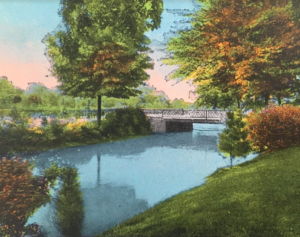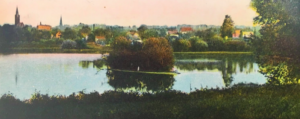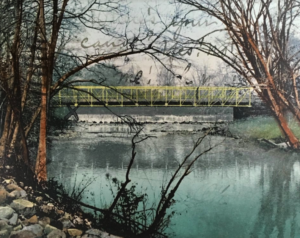Wallingford’s Community Lake was once a beautiful body of water enjoyed by many local organizations and Wallingford residents. The lake has now been reduced to a meager collection of muddy ponds. While the lake was a Wallingford staple for many years, the forty-five-mile stretch of the Quinnipiac River long predated it. A local community known as the Oneida constructed a dam on the river to power a factory that produced silver spoons, imitating the infrastructural additions that other groups had built on the banks of the Quinnipiac River throughout the 19th century. The dam eventually flooded, creating Community Lake.
Community Lake’s origin is directly attributed to a little known, short lived local group called the Oneida commune, whose Wallingford branch established itself in 1850. The Oneida were very religious and considered the Bible their constitution. Adults collectively raised the community’s children and were non-monogamous. The Oneida commune originally focused on agriculture and grew produce like strawberries, raspberries, and grapes. The Wallingford Oneidas soon converted to more industrial practices, thus explaining the creation of a dam to power their spoon factory. As time went on and more competition arose on the banks of the Quinnipiac River, the Oneida abandoned the lake created by their dam. In 1881, the community left Wallingford and moved to New York where they established Oneida Limited, a joint-stock silverware company that is still in business today.
The interesting history of the Oneida community is what introduced Mr. Erik Freeman, a Choate Humanities teacher, to Community Lake. Mr. Freeman expressed that it was valuable to him to learn about the town he lives in. He first learned about the lake from a 19th century book that discussed the Oneida commune and former lake. “I realized there wasn’t a lake, and so I looked it up and found maps that had this big lake in the center of town,” explained Mr. Freeman. Mr. Freeman teaches the class “The Greening of America: The Environmental Movement,” for which he wrote an iBook that describes the various phases of the lake’s history. “I wanted to use local history for classes,” said Mr. Freeman. “I’m also really interested in environmental history, and so I thought it was an interesting topic to look at.”
The lake’s purpose shifted to recreational use after the departure of the Oneida community, as depicted in multiple postcards from the time period. The lake was used by townspeople for fishing and boating, as well as ice skating in the winter. Eventually, another community in Wallingford began using the lake: The Choate School.
In the early 1910s, Choate established its interscholastic crew team. Prior to this, the boys would canoe on the Quinnipiac River as an intramural sport. As it was only a short walk from campus, Community Lake was a convenient location for Choate’s rowers. The townspeople would come to the lake and watch the boys race on Saturday mornings. Some of the races were against Yale freshmen, and, at times, the boats of the Choate team would race against each other. Next to the lake stood a boathouse used by Choate, a structure that still stands today but was given to the town of Wallingford two or three years ago.
From an environmental standpoint, the lake and those who used it had an immense impact on local ecosystems. “All the other silverware companies that lined the Quinnipiac River were polluting the lake,” explained Mr. Freedman. “Choate started using the lake without thinking about all of the different pollutants.” These pollutants included sewage, toxic waste, pesticides, and other harmful chemicals. Knowledge of these pollutants is not what stopped Choate from using the lake, however. In late January of 1979, the lake was washed out by a flood, and the dam collapsed, completely preventing its use. This damage unfortunately came right after discussion of plans to clean the lake, dredge toxic sediment, and build a recreational center on its banks.
When the dam collapsed and the lake mostly disappeared, it erased knowledge of Oneida history and damaged the widely-used recreational gathering place of Wallingford townspeople. Many Wallingford residents think the restoration of the lake would be a great addition to Wallingford and its community. The price to do so, however, would be very grand. As current mayor Mr. William Dickinson Jr. told The New York Times, “It would certainly be a wonderful facility. But the town is not currently in the position to take on a $25 million project.”







